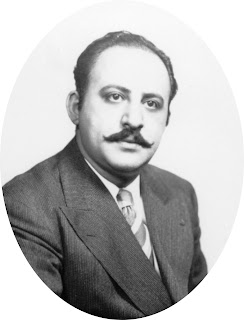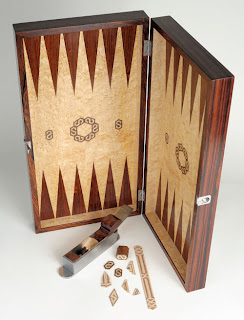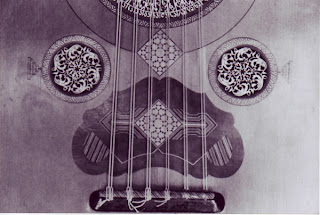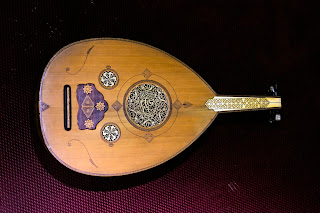Abdo Nahat was arguably the greatest oud maker to have ever lived. That's him above, still breathing life from the inside of one his creations. Nice mustache. Back when craftsman had class, and dressed like it. Oh, but we've progressed, I forgot. Abdo reminds me of my grandfather, who also had a fantastic mustache and also dressed with class.
 |
| Ibrahim Salim Khalaf (Abe Abraham) |
We don't know a lot about the Nahats. They were a large family of oud makers that were active from the mid 19th century until about the late 1980's. As Christians living in Damascus, Syria during Ottoman times and later during the French Mandate of the early 20th century they may have had to deal with political and religious issues that forced them to relocate. The remaining craftsmen moved to Sao Paolo, Brazil in the mid-20th century.
Most of the Nahats (George, John, Anton, among others) made fine instruments. In fact, they also made fine furniture, as this was their primary occupation in their shops in Damascus. In Arabic, "Nahat" means wood worker, which would suggest a long history in the trade. Abdo's label (pictured above) was printed in Arabic and French and reads "Carpentry Shop" along with the shop's address and description of the shop's services offering oriental furniture at a discount price.
As is typical of Arab society, little value is placed on historical objects. Instruments of incredible delicacy and craftsmanship are often left to neglect. One of the ouds below was found under layers of dust in the back of a guitar shop in California, apparently traded in or simply sold for a few dollars when the person no longer wanted it. It is a tour-de-force of craftsmanship.
Inspired by the the work of Abdo Nahat, I began duplicating some of the designs that he featured on his instruments. I barely scratched the surface when I realized how skilled this man was.
After I attained some measure of success in duplicating these elements, I began incorporating them into my instruments. A couple years ago my work caught the eye of Christopher Schwarz, editor of Popular Woodworking Magazine, and over dinner one night Chris approached me about writing an article for the magazine. The current (April) issue of the magazine features the article. You can buy it at most newsstands, or directly online at this link.
I also developed a way of fabricating these inlays with the Bridge City Tools Jointmaker Pro saw. The technique warrants its own article, but in the meantime, here are some pictures showing some samples of the technique using the Jointmaker Pro. Yes, its an expensive machine. But its the only one capable of mass-producing these designs with precision.
The article is fairly limited in scope regarding designs. I basically make one design in it. If you don't feel particularly inspired to try this technique, I offer the following examples from Abdo Nahat himself. These three masterpieces were all made in the same year, 1917.
The first of these probably made its way to southern California when an immigrant family relocated in the first half of the last century. It was found by the late Hamza El Din, hanging in the back of McCabe's guitar shop in Santa Monica. Hamza obtained the oud in exchange for a live performance at the store, plus less than $100, if I remember correctly. Hamza died about 4 years ago, and I assume this instrument is still in the possession of his widow. Efforts by me to obtain further information about this instrument have met with little results. Pictures courtesy of Daniel O'Donnell.
The second example was owned by the Turkish oudist Serif Muhiddin Targan. It now resides in a museum in Konya, Turkey. It sits in a plain glass case along with an assortment of instruments as part of an exhibit of Turkish instruments. A real shame that such a fine piece should be relegated to such a place. In my opinion it should have its own case, or better yet, be played by an professional musician. I apologize for the poor quality of these pictures. Most of these were taken through the glass with a cell phone camera by a friend of Faruk Turunz.
The final 1917 Abdo Nahat example was sent to me just a few weeks ago. It is part of a private collection. Appreciate the work by zooming in. Many of these details are wrought in bone and ivory. This is fine work, and at almost 100 years old, is nearly as crisp and detailed as the day it was made.





















